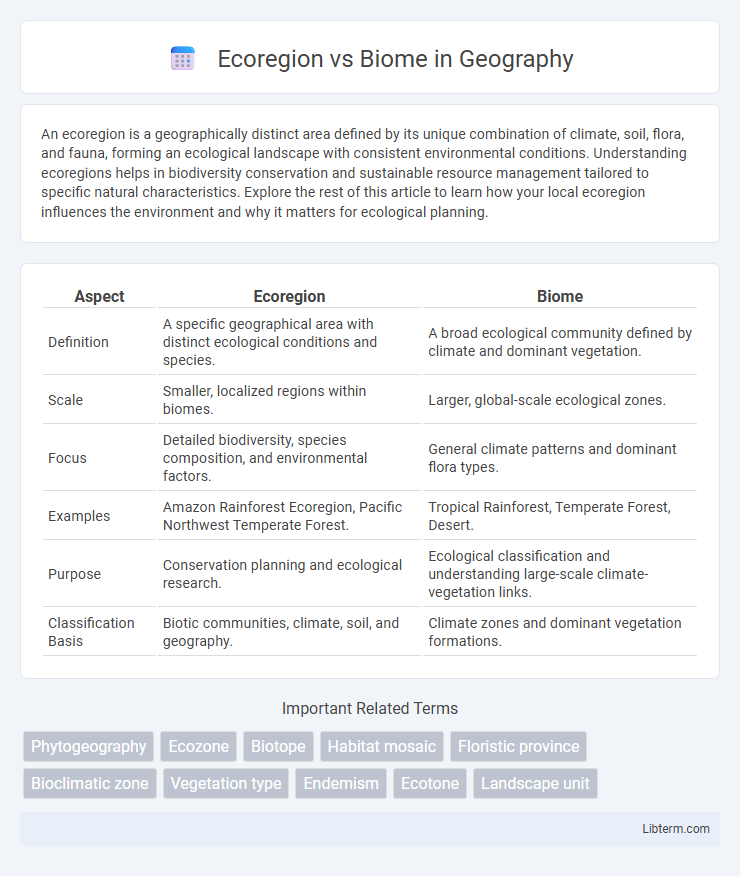An ecoregion is a geographically distinct area defined by its unique combination of climate, soil, flora, and fauna, forming an ecological landscape with consistent environmental conditions. Understanding ecoregions helps in biodiversity conservation and sustainable resource management tailored to specific natural characteristics. Explore the rest of this article to learn how your local ecoregion influences the environment and why it matters for ecological planning.
Table of Comparison
| Aspect | Ecoregion | Biome |
|---|---|---|
| Definition | A specific geographical area with distinct ecological conditions and species. | A broad ecological community defined by climate and dominant vegetation. |
| Scale | Smaller, localized regions within biomes. | Larger, global-scale ecological zones. |
| Focus | Detailed biodiversity, species composition, and environmental factors. | General climate patterns and dominant flora types. |
| Examples | Amazon Rainforest Ecoregion, Pacific Northwest Temperate Forest. | Tropical Rainforest, Temperate Forest, Desert. |
| Purpose | Conservation planning and ecological research. | Ecological classification and understanding large-scale climate-vegetation links. |
| Classification Basis | Biotic communities, climate, soil, and geography. | Climate zones and dominant vegetation formations. |
Introduction to Ecoregions and Biomes
Ecoregions are geographically distinct areas defined by their unique combinations of climate, soil, and biodiversity, providing detailed ecological classifications. Biomes encompass broader categories of ecosystems characterized primarily by similar climate conditions and dominant vegetation types across large regions. Understanding ecoregions allows for precise conservation planning by highlighting biological distinctiveness within the overarching structure of biomes.
Defining Ecoregions: Key Characteristics
Ecoregions are geographically distinct areas defined by their specific environmental conditions, ecological features, and species communities, which exhibit relatively uniform climate, vegetation, and soil types. Unlike biomes, which are broader categories based primarily on general climate and dominant vegetation, ecoregions capture finer-scale ecological variation and biodiversity patterns. Key characteristics of ecoregions include unique assemblages of flora and fauna, distinct ecosystem processes, and consistent abiotic factors such as temperature, precipitation, and altitude.
Understanding Biomes: Broad Classification
Biomes represent broad ecological classifications that group regions based on shared climate, vegetation, and animal life, such as tropical rainforests, deserts, and tundras. Unlike ecoregions, which are smaller and more specific areas with distinct ecological features, biomes provide a generalized framework to understand global biodiversity patterns. This broad classification helps scientists study ecosystem functions and responses to environmental changes across large geographic scales.
Geographic Scale: Ecoregion vs. Biome
Ecoregions represent smaller, more specific geographic areas characterized by distinct ecological patterns and environmental conditions within a larger biome. Biomes cover broad global zones defined primarily by climate and dominant vegetation types, such as tropical rainforests or deserts. The geographic scale of ecoregions allows for detailed conservation planning and biodiversity assessments, while biomes provide a general framework for understanding large-scale ecological similarities.
Biodiversity Differences in Ecoregions and Biomes
Ecoregions represent smaller, more specific ecological zones characterized by unique assemblages of species and environmental conditions, resulting in higher localized biodiversity compared to broader biomes. Biomes encompass large geographic areas defined primarily by climate and dominant vegetation types, which tend to support diverse but more generalized species adapted to those broad conditions. The fine-scale variation within ecoregions often fosters endemic species and specialized habitats, contributing significantly to global biodiversity beyond what is captured by biome-level classifications.
Climate Influence on Ecoregions and Biomes
Ecoregions and biomes are both ecological classifications influenced heavily by climate, but biomes represent broad global patterns shaped primarily by temperature and precipitation, resulting in major vegetation types such as tropical rainforests or deserts. Ecoregions are more specific areas within biomes that account for climate variability alongside factors like soil type and elevation, leading to distinct ecosystems with unique species compositions. Climate dictates the distribution and characteristics of both, with ecoregions reflecting finer-scale climate differences and microclimates that influence biodiversity and ecological processes.
Human Impact: Ecoregion vs. Biome Perspective
Human impact on ecoregions is often more localized and specific, affecting biodiversity, water cycles, and soil integrity within distinct ecological boundaries. Biomes experience broader-scale changes driven by climate alteration, deforestation, and land-use shifts impacting global ecosystem functions and species distributions. Conservation efforts targeting ecoregions can address detailed habitat protection, while biome-level strategies focus on large-scale climate resilience and ecosystem connectivity.
Mapping and Classification Systems
Ecoregions provide detailed, geographically explicit mapping based on specific ecological patterns such as climate, soil, and species distribution, enabling precise conservation planning. Biomes represent broader classification systems grouping large areas by general vegetation types and climate zones, facilitating global-scale ecological studies. The integration of ecoregion maps within biome frameworks enhances the accuracy of biodiversity assessments and habitat management strategies.
Case Studies: Examples of Ecoregions and Biomes
Ecoregions such as the Amazon Rainforest showcase a unique assemblage of flora and fauna adapted to tropical moist conditions, while the Taiga biome represents the largest terrestrial biome characterized by boreal forests spanning North America and Eurasia. The Great Barrier Reef ecoregion exemplifies marine biodiversity hotspots within the Coral Reef biome, illustrating distinct ecological processes across scale. Case studies highlight how ecoregions provide finer resolution in conservation efforts compared to broader biome classifications by capturing localized environmental heterogeneity and species distribution.
Importance in Conservation and Environmental Management
Ecoregions represent specific geographic areas defined by distinct ecological features and species assemblages, providing a finer scale for targeted conservation efforts compared to broader biomes. Understanding ecoregions allows environmental managers to implement localized strategies that address unique habitat requirements and threats, promoting biodiversity preservation effectively. Biomes, encompassing larger climate-driven ecosystems, offer essential context for global conservation priorities but lack the resolution needed for detailed management plans critical to sustaining ecological integrity.
Ecoregion Infographic

 libterm.com
libterm.com